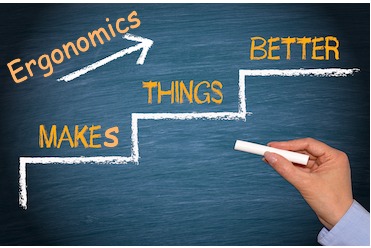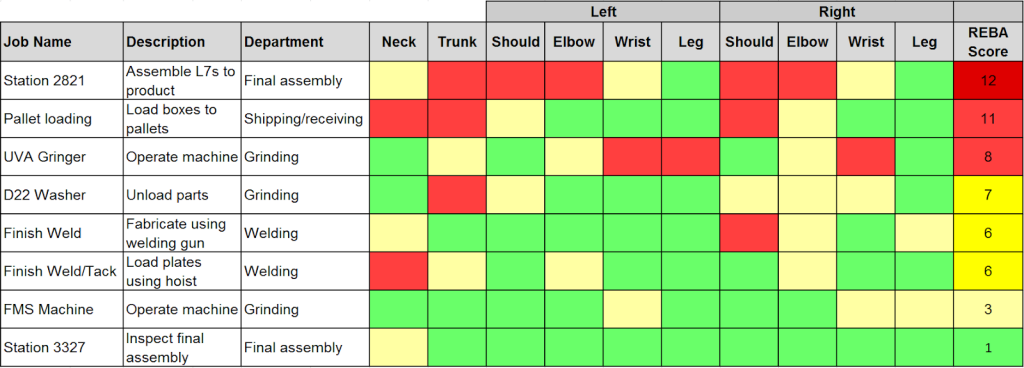
Successful workplace ergonomics programs drive improvements that reduce ergonomics risk while making jobs easier, effective and less painful for workers. Since Lean and Six Sigma programs also focus on driving workplace improvements, there’s a substantial amount of activity already happening in companies that can be harnessed for improving ergonomics. The key is systematically linking the activities.
Frame the Benefits of Ergonomics in Continuous Improvement Terms
Before diving into how ergonomics improvement activities can be linked with Lean and Six Sigma initiatives, you need to recruit the leaders of these programs to want to help. Focus first on why they should systematically support ergonomics. There are three main points you’ll want to make:
- Workplace ergonomics is a continuous improvement activity, so it’s a natural fit for the Lean or Six Sigma process they are leading. If they don’t include ergonomics in their programs, ergonomics improvement activities will be happening at the same time as their initiatives – sometimes in the same areas – without any coordination.
- Worker engagement is often one of the biggest barriers for Lean and Six Sigma activities. Workers experience immediate and highly impactful benefits from ergonomics improvements – easier and less painful work. Consequently, ergonomics is very attractive for them to actively participate. This direct worker benefit is a missing piece in many Lean and Six Sigma initiatives, and has shown to be a game changer in companies that systematically embrace ergonomics in their continuous improvement efforts.
- Ergonomics risk is a relatively easy metric to quantify that fits nicely into the metrics tracking process for Lean and Six Sigma projects. The current state can be established, workplace modifications can be identified to improve the metric, and the future state can be measured to show the ergonomics risk improvement. Done right, ergonomics is an easy fit for continuous improvement initiatives.
Finding the Right Ergonomics Metrics
The key to systematically linking ergonomics improvement activities to Lean and Six Sigma initiatives is to gain agreement on the appropriate leading metric. “Ergonomics success” is often discussed in the context of reducing MSD injuries, but injuries are a lagging metric and Lean/Six Sigma projects are driven by leading metrics.
Lagging metrics are outputs of a process – they are easy to measure but can’t be directly influenced. Leading metrics are inputs to a process, hard to measure but can be directly influenced. Resolving the measurement challenge for ergonomics – adopting a leading metric for ergonomics risk – is what makes ergo a natural fit for any Lean or Six Sigma project.
A simple approach to establishing a leading metric for ergonomics risk is to adopt one assessment tool that can be applied to all jobs. By standardizing on an ergonomics screening survey such as REBA, companies can quantify ergonomics risk at the beginning of a project, target areas for improvement, and verify the risk score has changed at the end of the project.

A more sophisticated approach for measuring ergonomics risk is to adopt a suite of ergonomics assessment tools that can be applied to different types of work. This approach is often needed when ergonomics screening surveys aren’t a good fit – typically when there are non-repetitive tasks present, or when the screening surveys aren’t sensitive enough. A standard set of ergonomics analysis tools can be used, so long as the threshold for high risk is understood. In the example below, the scoring scale for each tool is different, so scores are translated to a red-yellow-green rating commonly used in Lean and Six Sigma tools.

Linking Ergonomics to Lean and Six Sigma
Once agreement is achieved on how the company will measure ergonomics risk, specific activities can be identified to ensure that ergonomics assessment and improvement activities are integrated into Lean and Six Sigma projects. It’s best if you take the time to understand how the Lean or Six Sigma process works at your company, and recommend specific ergonomics activities that can be integrated into the continuous improvement process.
For Lean projects, examples of specific ergonomics activities that can be adopted are:
- Assess all jobs for ergonomics risk during current state analysis, for example during value stream mapping or in preparation for kaizen events
- Include ergonomics issues in 5S audit checklists
- Implement workplace improvements to reduce ergonomics risk below “high risk”
- Report ergonomics risk levels at the conclusion of all Lean improvement projects
For Six Sigma projects, specific ergonomics activities can be built into the DMAIC improvement process. DMAIC (Define, Measure, Analyze, Improve, Control) is a common methodology for improving existing operations using Six Sigma tools. Methodologies vary for designing new products or processes, but you should still link specific ergonomics considerations to Design for Six Sigma (DFSS) activities.
| Six Sigma DMAIC Step | Ergonomics Activities |
| Define the improvement activity | Include improving ergonomics in the project goals |
| Measure the existing process performance | Interview workers for ergonomics issues and establish a baseline ergonomic risk score |
| Analyze the process to identify root causes and potential improvements | Involve workers in generating and evaluating ergonomics improvement ideas |
| Improve the process | Conduct a follow-up ergonomics assessment (risk score and worker interviews) |
| Control the process to sustain improvements | Conduct a 30-day check-up and apply ergonomic improvements to similar jobs |
Along with linking ergonomics activities with Lean and Six Sigma projects, you will need to work with the continuous improvement leadership team to clearly identify roles and responsibilities for the activities, and ensure that appropriate ergonomics training is provided to support individuals to fulfill their assigned responsibilities. You can download Ergoweb’s Guide 5 Essential Elements of a Successful Ergonomics Process to learn more about roles and responsibilities for ergonomics:
